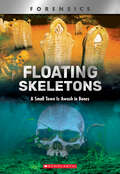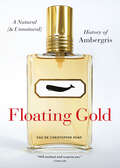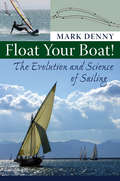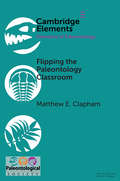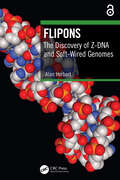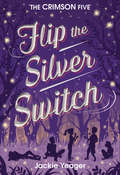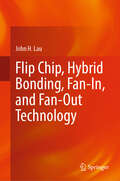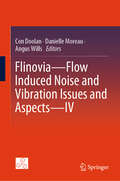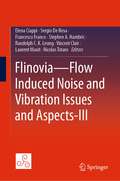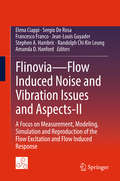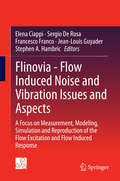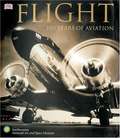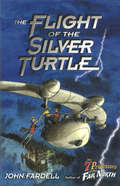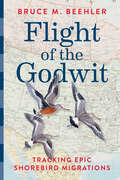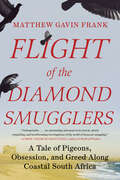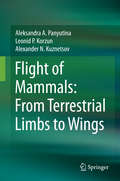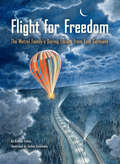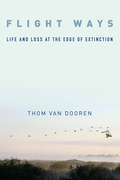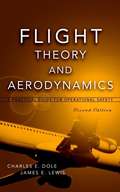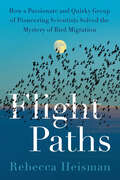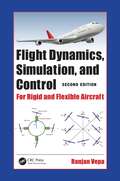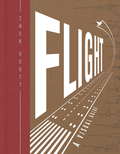- Table View
- List View
Floating Skeletons: A Small Town Is Awash in Bones (XBooks: Forensics)
by Danielle DenegaWho will put the dead back to rest?It's the Great Flood of 1993, and much of the Midwestern U.S. is covered with water. But tiny Hardin, Missouri, is covered with something much, much worse: dead bodies.High-interest topics, real stories, engaging design, and astonishing photos are the building blocks of the XBooks, a new series of books designed to engage and motivate reluctant and enthusiastic readers alike. How can DNA help a convicted person prove their innocence? How did a burglar steal from a store without leaving any fingerprints? Why was the tiny town in Hardin, Missouri, awash with skeletons after a huge flood? With topics based in science, these action-packed books will help students unlock the power and pleasure of reading... and always ask for more!
Floating Gold: A Natural (& Unnatural) History of Ambergris
by Christopher KempA fascinating natural history of an incredibly curious substance. “Preternaturally hardened whale dung” is not the first image that comes to mind when we think of perfume, otherwise a symbol of glamour and allure. But the key ingredient that makes the sophisticated scent linger on the skin is precisely this bizarre digestive by-product—ambergris. Despite being one of the world’s most expensive substances (its value is nearly that of gold and has at times in history been triple it), ambergris is also one of the world’s least known. But with this unusual and highly alluring book, Christopher Kemp promises to change that by uncovering the unique history of ambergris. A rare secretion produced only by sperm whales, which have a fondness for squid but an inability to digest their beaks, ambergris is expelled at sea and floats on ocean currents for years, slowly transforming, before it sometimes washes ashore looking like a nondescript waxy pebble. It can appear almost anywhere but is found so rarely, it might as well appear nowhere. Kemp’s journey begins with an encounter on a New Zealand beach with a giant lump of faux ambergris—determined after much excitement to nothing more exotic than lard—that inspires a comprehensive quest to seek out ambergris and its story. He takes us from the wild, rocky New Zealand coastline to Stewart Island, a remote, windswept island in the southern seas, to Boston and Cape Cod, and back again. Along the way, he tracks down the secretive collectors and traders who populate the clandestine modern-day ambergris trade.Floating Gold is an entertaining and lively history that covers not only these precious gray lumps and those who covet them, but presents a highly informative account of the natural history of whales, squid, ocean ecology, and even a history of the perfume industry. Kemp’s obsessive curiosity is infectious, and eager readers will feel as though they have stumbled upon a precious bounty of this intriguing substance.
Float Your Boat!: The Evolution and Science of Sailing
by Mark DennyAn estimated 4.1 million people in the United States participate in recreational sailing. Yet the large library of sailing literature leaves many of them high and dry. On one side are technical guides for America’s Cup boat-builders; on the other, simplistic books for weekend sailors with little interest in science. In Float Your Boat! professional and amateur boaters alike will find intelligent and understandable answers to such questions as: What were the key innovations that made sailboats more efficient? How do you increase the speed of a boat? How do sailboats travel into the wind? Why are so many explanations of sailing so wrong? Sailing enthusiast and physicist Mark Denny first traces the evolution of the sailing craft, from prehistoric coracles made of animal skins and antlers to the sailboat’s reinvention as a pleasure craft during the Industrial Revolution. He then identifies specific sailing phenomena—how wind drives modern Bermuda sloops, how torque determines stability, why hull speed exists—and provides the key physics principles behind them. Whether you are an inquisitive landlubber who has never set foot in a boat, a casual weekend sailor, or an old salt who lives for the sea, Float Your Boat! is an accessible guide to the physics of sailing.
Flipping the Paleontology Classroom: Benefits, Challenges, and Strategies (Elements of Paleontology)
by Matthew E. ClaphamLecturing has been a staple of university pedagogy, but a shift is ongoing because of evidence that active engagement with content helps strengthen learning and build more advanced skills. The flipped classroom, which delivers content to students outside of the class meeting, is one approach to maximize time for active learning. The fundamental benefit of a flipped class is that students learn more, but ensuring student preparation and engagement can be challenging. Evaluation policies can provide incentives to guide student effort. Flipping a class requires an initial time commitment, but the workload associated with evaluating student work during the course can be mitigated. The personal interactions from active learning are extremely rewarding for students and instructors, especially when class sizes are small and suitable room layouts are available. Overall, flipping a course doesn't require special training, just a willingness to experiment, reflect, and adjust.
Flipons: The Discovery of Z-DNA and Soft-Wired Genomes
by Alan HerbertAlan Herbert has played a leading part in discovering the biological roles for a high-energy form of DNA twisted to the left rather than to the right. Both Z-DNA and the Z-RNA sensing proteins are critical for protecting hosts against both viruses and cancers. The proteins also play critical roles in the programmed cell death of aging cells. Other types of flipons exist and alter the readout of transcripts from the genome, encoding genetic information by their shape rather than by their sequence. Many of these flipons are within repeat elements that were previously considered to be just genomic junk. Instead these genetic elements increase the adaptability of cells by flipping DNA conformation. By acting as digital switches, the different flipon types can alter cellular responses without any change to their sequence or any damage to DNA. These highly dynamic structures enable the rapid evolution of multicellular organisms. The junk DNA in repeats also encode peptide patches that enable the assembly of cellular machines. The intransitive logic involved enhances the chance of an individual surviving a constantly changing environment.Key Features Causes us to rethink how information is encoded in the genome Changes our understanding of how our genome evolved and how we protect ourselves against viruses and cancers while sparing normal cells Shows that high energy forms of DNA, such as left-handed DNA do exist inside the cell Accessible to those in academia and the general public, and speaks to the next generation, encouraging them to find their own path in scientific discovery The Open Access version of this book, available at http://www.taylorfrancis.com, has been made available under a Creative Commons Attribution-Non-Commercial-No Derivative License (CC-BY-NC-ND) 4.0 license.
Flip the Silver Switch (The Crimson Five #2)
by Jackie YeagerThe Crimson Five are headed to the Piedmont Global Championships in Quebec, where they'll compete against the best inventor teams in the world. Kia and her New York teammates are excited to share a new amazing invention — but they're blind-sided with another task to solve, with just two weeks to do it!As the team struggles with a lack of creativity, rumors leave The Crimson Five questioning everything about each other. Kia knows she and her team must come together like never before in order to win a coveted spot on the Swirl and Spark Creativity Tour, but tragedy threatens to derail all that they've built.The Crimson Five are together again.Because sometimes it takes a whole team to help you see things clearly.
Flip Chip, Hybrid Bonding, Fan-In, and Fan-Out Technology
by John H. LauThis book focuses on the design, materials, process, fabrication, and reliability of flip chip, hybrid bonding, fan-in, and fan-out technology. Both principles and engineering practice have been addressed, with more weight placed on engineering practice. This is achieved by providing in-depth study on a number of major topics such as wafer bumping, flip chip assembly, underfill and reliability, chip-to-wafer, wafer-to-wafer, Cu-Cu hybrid bonding, WLCSP, 6-side molded WLCSP, FOWLP such as hybrid substrates with PID, ABF, and ultra-large organic interposer, the communications between chiplets and heterogeneous integration packaging, and on-board optics, near-package optics, and co-packaged optics.The book benefits researchers, engineers, and graduate students in the fields of electrical engineering, mechanical engineering, materials sciences, industry engineering, etc.
Flinovia—Flow Induced Noise and Vibration Issues and Aspects—IV
by Danielle Moreau Con Doolan Angus WillsThis book gathers the latest advances and innovations in the field of flow-induced vibration and noise, as presented by leading international researchers at the 4th International Symposium on Flow-Induced Noise and Vibration Issues and Aspects (FLINOVIA), which was held in Sydney, Australia, in May 2023. It explores topics such as turbulent boundary layer-induced vibration and noise, noise due to ingested turbulence, rotor noise, fluid-structure interaction problems, innovative measurement methods, and noise control techniques. The authors’ backgrounds represent a mix of academia, government, and industry, and several papers include applications to important problems for underwater vehicles, aerospace applications, and commercial transportation. The book offers a valuable reference guide for all those interested in measurement, modelling, simulation, and reproduction of the flow excitation and flow-induced structural response.
Flinovia—Flow Induced Noise and Vibration Issues and Aspects-III
by Stephen A. Hambric Elena Ciappi Sergio De Rosa Francesco Franco Randolph C. K. Leung Vincent Clair Laurent Maxit Nicolas TotaroThis volume gathers the latest advances and innovations in the field of flow-induced vibration and noise, as presented by leading international researchers at the 3rd International Symposium on Flow Induced Noise and Vibration Issues and Aspects (FLINOVIA), which was held in Lyon, France, in September 2019. It explores topics such as turbulent boundary layer-induced vibration and noise, tonal noise, noise due to ingested turbulence, fluid-structure interaction problems, and noise control techniques. The authors’ backgrounds represent a mix of academia, government, and industry, and several papers include applications to important problems for underwater vehicles, aerospace structures and commercial transportation. The book offers a valuable reference guide for all those interested in measurement, modelling, simulation and reproduction of the flow excitation and flow induced structural response.
Flinovia—Flow Induced Noise and Vibration Issues and Aspects-II: A Focus on Measurement, Modeling, Simulation and Reproduction of the Flow Excitation and Flow Induced Response
by Jean-Louis Guyader Stephen A. Hambric Elena Ciappi Sergio De Rosa Francesco Franco Randolph Chi Kin Leung Amanda D. HanfordThis is the proceedings of the Second International Workshop on Flow Induced Noise and Vibration (FLINOVIA), which was held in Penn State, USA, in April 2016. The authors’ backgrounds represent a mix of academia, government, and industry, and several papers include applications to important problems for underwater vehicles, aerospace structures and commercial transportation. The book offers a valuable reference guide for all those working in the area of flow-induced vibration and noise.Flow induced vibration and noise (FIVN) remains a critical research topic. Even after over 50 years of intensive research, accurate and cost-effective FIVN simulation and measurement techniques remain elusive. This book gathers the latest research from some of the most prominent experts in the field.The book describes methods for characterizing wall pressure fluctuations, including subsonic and supersonic turbulent boundary layer flows over smooth and rough surfaces using computational methods like Large Eddy Simulation; for inferring wall pressure fluctuations using inverse techniques based on panel vibrations or holographic pressure sensor arrays; for calculating the resulting structural vibrations and radiated sound using traditional finite element methods, as well as advanced methods like Energy Finite Elements; for using scaling approaches to universally collapse flow-excited vibration and noise spectra; and for computing time histories of structural response, including alternating stresses.
Flinovia - Flow Induced Noise and Vibration Issues and Aspects
by Jean-Louis Guyader Stephen A. Hambric Elena Ciappi Sergio De Rosa Francesco FrancoFlow induced vibration and noise (FIVN) remains a critical research topic. Even after over 50 years of intensive research, accurate and cost-effective FIVN simulation and measurement techniques remain elusive. This book gathers the latest research from some of the most prominent experts in the field. It describes methods for characterizing wall pressure fluctuations, including subsonic and supersonic turbulent boundary layer flows over smooth and rough surfaces using computational methods like Large Eddy Simulation; for inferring wall pressure fluctuations using inverse techniques based on panel vibrations or holographic pressure sensor arrays; for calculating the resulting structural vibrations and radiated sound using traditional finite element methods, as well as advanced methods like Energy Finite Elements; for using scaling approaches to universally collapse flow-excited vibration and noise spectra; and for computing time histories of structural response, including alternating stresses. This book presents the proceedings of the First International Workshop on Flow Induced Noise and Vibration (FLINOVIA), which was held in Rome, Italy, in November 2013. The authors' backgrounds represent a mix of academia, government, and industry, and several papers include applications to important problems for underwater vehicles, aerospace structures and commercial transportation. The book offers a valuable reference guide for all those working in the area of flow-induced vibration and noise.
Flight: 100 Years of Aviation
by R. G. GrantThis groundbreaking book charts the inspirational story behind humankind's conquest of the skies. From record-breaking flights and aerial warfare, to advances in aircraft design and the race for space, Flight covers the most memorable moments in the history of aviation. Flight is a gripping narrative of humankind's quest to conquer the skies and explore space.
Flight of the Silver Turtle
by John FardellThe take-charge kids from John Fardell's The 7 Professors of the Far North face a summer packed with danger, excitement and suspense--flying airplanes, scuba diving, cracking codes and even taking a spin in the world's first antigravity backpack as they plunge into this fast-paced, high- flying adventure. Ben, Zara, Sam and Marcia begin their summer vacation by helping Professor Ampersand build the Silver Turtle, a high-tech airplane. This is thrilling enough, but things take an even wilder turn when a strange woman steals the airplane with the kids inside. She's trying to evade members of Noctarma, an international criminal organization that thinks the airplane is carrying a secret antigravity device that could be the key to world domination. They've got the wrong Silver Turtle, but they've also captured Professor Ampersand--and the kids will have to pull out all the stops to find the real Silver Turtle device before Noctarma does.
Flight of the Godwit: Tracking Epic Shorebird Migrations
by Bruce M. BeehlerSoar across 46 North American territories to uncover the secrets of 7 magnificent shorebirds, the world&’s greatest nonstop travelersAn immersive travelogue that belongs on every birder's bookshelf, with 30 gorgeous black-and-white illustrations and a birdwatching species checklistFlying more than 8,000 miles from Alaska to eastern Australia without stopping to eat or rest, the Bar-tailed Godwit holds the record for the longest nonstop migration of any land bird in the world. Flight of the Godwit invites readers on ornithologist Bruce M. Beehler's awe-inspiring journey in search of North America's largest and farthest-flying shorebirds. Driving 35,000 miles between 2019 to 2023, Beehler sought birds he dubs the "Magnificent Seven": Hudsonian GodwitBar-tailed GodwitMarbled GodwitWhimbrelLong-billed CurlewBristle-thighed CurlewUpland SandpiperBeehler interweaves colorful fieldwork stories and rich details on local culture with the natural history and biology of shorebirds—including evolution, the physics of migration, orientation, homing, foraging, diet, nesting, parental care, wintering, staging, elusive "super-migrators," and the importance of conservation efforts.With authoritative prose and 30 beautiful black-and-white illustrations from artist Alan T. Messer, the book journeys through 37 states and 9 Canadian provinces from Texas to Alaska to Canada's High Arctic. Flight of the Godwit is a captivating adventure and a tribute to remarkable birds and birding itself.
Flight of the Diamond Smugglers: A Tale Of Pigeons, Obsession, And Greed Along Coastal South Africa
by Matthew Gavin Frank“Unforgettable. . . . An outstanding adventure in its lyrical, utterly compelling, and heartbreaking investigations of the world of diamond smuggling.” —Aimee Nezhukumatathil For nearly eighty years, a huge portion of coastal South Africa was closed off to the public. With many of its pits now deemed “overmined” and abandoned, American journalist Matthew Gavin Frank sets out across the infamous Diamond Coast to investigate an illicit trade that supplies a global market. Immediately, he became intrigued by the ingenious methods used in facilitating smuggling?particularly, the illegal act of sneaking carrier pigeons onto mine property, affixing diamonds to their feet, and sending them into the air. Entering Die Sperrgebiet (“The Forbidden Zone”) is like entering an eerie ghost town, but Frank is surprised by the number of people willing—even eager—to talk with him. Soon he meets Msizi, a young diamond digger, and his pigeon, Bartholomew, who helps him steal diamonds. It’s a deadly game: pigeons are shot on sight by mine security, and Msizi knows of smugglers who have disappeared because of their crimes. For this, Msizi blames “Mr. Lester,” an evil tall-tale figure of mythic proportions. From the mining towns of Alexander Bay and Port Nolloth, through the “halfway” desert, to Kleinzee’s shores littered with shipwrecks, Frank investigates a long overlooked story. Weaving interviews with local diamond miners who raise pigeons in secret with harrowing anecdotes from former heads of security, environmental managers, and vigilante pigeon hunters, Frank reveals how these feathered bandits became outlaws in every mining town. Interwoven throughout this obsessive quest are epic legends in which pigeons and diamonds intersect, such as that of Krishna’s famed diamond Koh-i-Noor, the Mountain of Light, and that of the Cherokee serpent Uktena. In these strange connections, where truth forever tangles with the lore of centuries past, Frank is able to contextualize the personal grief that sent him, with his wife Louisa in the passenger seat, on this enlightening journey across parched lands. Blending elements of reportage, memoir, and incantation, Flight of the Diamond Smugglers is a rare and remarkable portrait of exploitation and greed in one of the most dangerous areas of coastal South Africa. With his sovereign prose and insatiable curiosity, Matthew Gavin Frank “reminds us that the world is a place of wonder if only we look” (Toby Muse).
Flight of Mammals: From Terrestrial Limbs to Wings
by Aleksandra A. Panyutina Leonid P. Korzun Alexander N. KuznetsovThis book offers a new explanation for the development of flight in mammals and offers detailed morphological descriptions of mammals with flapping flight. The skeletomuscular apparatus of the shoulder girdle and forelimbs of tree shrews, flying lemurs and bats is described in detail. Special attention is paid to the recognition of peculiar features of the skeleton and joints. For the basic locomotor patterns of flying lemurs and bats, the kinematic models of the shoulder girdle elements are developed. The most important locomotor postures of these animals are analyzed by means of statics. The key structural characters of the shoulder girdle and forelimbs of flying lemurs and bats, the formation of which provided transition of mammals from terrestrial locomotion to gliding and then, to flapping flight, are recognized. The concept is proposed that preadaptations preceding the acquisition of flapping flight could have come from widely sprawled forelimb posture while gliding from tree to tree and running up the thick trunks. It is shown that flying lemur is an adequate morphofunctional model for an ancestral stage of bats. The evolutionary ecomorphological scenario describing probable transformational stages of typical parasagittal limbs of chiropteran ancestors into wings is developed.
Flight for Freedom: The Wetzel Family's Daring Escape from East Germany
by Kristen FultonAn Inspiring True Story about One Family's Escape from Behind the Berlin Wall!Peter was born on the east side of Germany, the side that wasn't free. He watches news programs rather than cartoons, and wears scratchy uniforms instead of blue jeans. His family endures long lines and early curfews. But Peter knows it won't always be this way. Peter and his family have a secret. Late at night in their attic, they are piecing together a hot air balloon—and a plan. Can Peter and his family fly their way to freedom? This is the true story of a boy and his family who risk their lives for the hope of freedom in a daring escape from East Germany via a handmade hot air balloon in 1979.• A perfect picture book for educators teaching about the Cold War, the Iron Curtain, and East Germany• Flight for Freedom is a showcase for lessons of bravery, heroism, family, and perseverance, as well as stunning history• Includes detailed maps of the Wetzel family's escape route and diagrams of their hot air balloonFor fans of historical nonfiction picture books like Let the Children March, The Wall, Growing Up Behind the Iron Curtain, and Armstrong: The Adventurous Journey of a Mouse to the Moon.• True life escape stories• For readers age 5–9• For teachers, librarians, and historiansKristen Fulton is a children's book author. She can always be found with a notebook in hand as she ventures through historical sites and museums. Most of the time she lives in Florida—but she can also be found traveling the country by RV.Torben Kuhlmann is an award-winning children's book author and illustrator. Starting in kindergarten he became known as "the draftsman." Flying machines and rich historical detail often adorn his work. He lives in Hamburg, Germany.
Flight Ways: Life and Loss at the Edge of Extinction (Critical Perspectives on Animals: Theory, Culture, Science, and Law)
by Thom van DoorenA leading figure in the emerging field of extinction studies, Thom van Dooren puts philosophy into conversation with the natural sciences and his ethnographic encounters to vivify the cultural and ethical significance of modern-day extinctions. Unlike other meditations on the subject, Flight Ways incorporates the particularities of real animals and their worlds, drawing philosophers, natural scientists, and general readers into the experience of living among and losing biodiversity.Each chapter of Flight Ways focuses on a different species or group of birds: North Pacific albatrosses, Indian vultures, an endangered colony of penguins in Australia, Hawaiian crows, and the iconic whooping cranes of North America. Written in eloquent and moving prose, the book takes stock of what is lost when a life form disappears from the world—the wide-ranging ramifications that ripple out to implicate a number of human and more-than-human others. Van Dooren intimately explores what life is like for those who must live on the edge of extinction, balanced between life and oblivion, taking care of their young and grieving their dead. He bolsters his studies with real-life accounts from scientists and local communities at the forefront of these developments. No longer abstract entities with Latin names, these species become fully realized characters enmeshed in complex and precarious ways of life, sparking our sense of curiosity, concern, and accountability toward others in a rapidly changing world.
Flight Ways: Life and Loss at the Edge of Extinction
by Thom Van DoorenA leading figure in the emerging field of extinction studies, Thom van Dooren puts philosophy into conversation with the natural sciences and his own ethnographic encounters to vivify the cultural and ethical significance of modern-day extinctions. Unlike other meditations on the subject, Flight Ways incorporates the particularities of real animals and their worlds, drawing philosophers, natural scientists, and general readers into the experience of living among and losing biodiversity.Each chapter of Flight Ways focuses on a different species or group of birds: North Pacific albatrosses, Indian vultures, an endangered colony of penguins in Australia, Hawaiian crows, and the iconic whooping cranes of North America. Written in eloquent and moving prose, the book takes stock of what is lost when a life form disappears from the world -- the wide-ranging ramifications that ripple out to implicate a number of human and more-than-human others. Van Dooren intimately explores what life is like for those who must live on the edge of extinction, balanced between life and oblivion, taking care of their young and grieving their dead. He bolsters his studies with real-life accounts from scientists and local communities at the forefront of these developments. No longer abstract entities with Latin names, these species become fully realized characters enmeshed in complex and precarious ways of life, sparking our sense of curiosity, concern, and accountability toward others in a rapidly changing world.
Flight Ways
by Thom Van DoorenA leading figure in the emerging field of extinction studies, Thom van Dooren puts philosophy into conversation with the natural sciences and his own ethnographic encounters to vivify the cultural and ethical significance of modern-day extinctions. Unlike other meditations on the subject, Flight Ways incorporates the particularities of real animals and their worlds, drawing philosophers, natural scientists, and general readers into the experience of living among and losing biodiversity.Each chapter of Flight Ways focuses on a different species or group of birds: North Pacific albatrosses, Indian vultures, an endangered colony of penguins in Australia, Hawaiian crows, and the iconic whooping cranes of North America. Written in eloquent and moving prose, the book takes stock of what is lost when a life form disappears from the world -- the wide-ranging ramifications that ripple out to implicate a number of human and more-than-human others. Van Dooren intimately explores what life is like for those who must live on the edge of extinction, balanced between life and oblivion, taking care of their young and grieving their dead. He bolsters his studies with real-life accounts from scientists and local communities at the forefront of these developments. No longer abstract entities with Latin names, these species become fully realized characters enmeshed in complex and precarious ways of life, sparking our sense of curiosity, concern, and accountability toward others in a rapidly changing world.
Flight Theory And Aerodynamics: A Practical Guide For Operational Safety
by James E. Lewis Charles E. DoleThe classic text for pilots on flight theory and aerodynamics now in an updated Second Edition Flight Theory and Aerodynamics, the basic aeronautics text used by the United States Air Force in their Flying Safety Officer course, is the book that brings the science of flight into the cockpit. Designed for the student with little engineering or mathematical background, the book outlines the basic principles of aerodynamics and physics, using only a minimal amount of high school level algebra and trigonometry necessary to illustrate key concepts. This expanded seventeen chapter Second Edition reflects the cutting edge of aeronautic theory and practice, and has been revised, reorganized, and updated with 30% new information including a new chapter on helicopter flight. Central to the book s structure is a clear description of aeronautic basics what lifts and drives an aircraft, and what forces work for and against it all detailed in the context of the design and analysis of today s aircraft systems: * Atmosphere and airspeed measurement * Airfoils and aerodynamic forces * Lift and drag * Jet aircraft basic and applied performance * Prop aircraft basic and applied performance * Slow and high-speed flight * Takeoff, landing, and maneuvering performance The book s practical, self-study format includes problems at the end of each chapter, with answers at the back of the book, as well as chapter-end summaries of symbols and equations. An ideal text for the USN Aviation Safety Officer and the USAAA s Aviation Safety Officer courses, as well as for professional pilots, student pilots, and flying safety personnel, Flight Theory and Aerodynamics is a complete and accessible guide to the subject, updated for the new millennium.
Flight Paths: How a Passionate and Quirky Group of Pioneering Scientists Solved the Mystery of Bird Migration
by Rebecca HeismanThe captivating, little-known true story of a group of scientists and the methods and technology they developed to uncover the secrets of avian migration.For the past century, scientists and naturalists have been steadily unravelling the secrets of bird migration. How and why birds navigate the skies, traveling from continent to continent—flying thousands of miles across the earth each fall and spring—has continually fascinated the human imagination, but only recently have we been able to fully understand these amazing journeys. Although we know much more than ever before, even the most enthusiastic birdwatcher may not know how we got here, the ways that the full breadth of scientific disciplines have come together to reveal these annual avian travels.Flight Paths is the never-before-told story of how a group of migration-obsessed scientists in the twentieth and twenty-first centuries engaged nearly every branch of science to understand bird migration—from where and when they take off to their flight paths and behaviors, their destinations and the challenges they encounter getting there. Uniting curious minds from across generations, continents, and disciplines, bird enthusiast and science writer Rebecca Heisman traces the development of each technique used for tracking migratory birds, from the first attempts to mark individual birds to the cutting-edge technology that lets ornithologists trace where a bird has been, based on unique DNA markers. Along the way, she touches on the biggest technological breakthroughs of modern science and reveals the almost-forgotten stories of the scientists who harnessed these inventions in service of furthering our understanding of nature (and their personal obsession with birds).The compelling and fascinating story of how scientists solved the great mystery of bird migration, Flight Paths is an unprecedented look into exciting, behind-the-scenes moments of groundbreaking discovery. Heisman demonstrates that the real power of science happens when people work together, focusing their minds and knowledge on a common goal. While the world looks to tackle massive challenges involving conservation and climate, the story of migration research offers a beacon of hope that we can find solutions to difficult and complex problems.
Flight Dynamics, Simulation, and Control: For Rigid and Flexible Aircraft
by Ranjan VepaFlight Dynamics, Simulation, and Control of Aircraft: For Rigid and Flexible Aircraft explains the basics of non-linear aircraft dynamics and the principles of control-configured aircraft design, as applied to rigid and flexible aircraft, drones, and unmanned aerial vehicles (UAVs). Addressing the details of dynamic modeling, simulation, and control in a selection of aircraft, the book explores key concepts associated with control-configured elastic aircraft. It also covers the conventional dynamics of rigid aircraft and examines the use of linear and non-linear model-based techniques and their applications to flight control. This second edition features a new chapter on the dynamics and control principles of drones and UAVs, aiding in the design of newer aircraft with a combination of propulsive and aerodynamic control surfaces. In addition, the book includes new sections, approximately 20 problems per chapter, examples, simulator exercises, and case studies to enhance and reinforce student understanding. The book is intended for senior undergraduate and graduate mechanical and aerospace engineering students taking Flight Dynamics and Flight Control courses. Instructors will be able to utilize an updated Solutions Manual and figure slides for their course.
Flight
by Zack ScottFlight is the story of humankind's most ambitious undertaking. From thousand-year-old flying machines and the trailblazing 'birdmen' who risked their lives to test them, to the Wright brothers' legendary first flight and the iconic spacecraft of the modern era, Flight weaves together the extraordinary history of aviation with an in-depth look at the mechanics of how planes work. Sumptuously illustrated and written by a former RAF technician, this is the definitive guide to how we conquered the skies.
Flight
by Zack ScottFlight is the story of humankind's most ambitious undertaking. From thousand-year-old flying machines and the trailblazing 'birdmen' who risked their lives to test them, to the Wright brothers' legendary first flight and the iconic spacecraft of the modern era, Flight weaves together the extraordinary history of aviation with an in-depth look at the mechanics of how planes work. Sumptuously illustrated and written by a former RAF technician, this is the definitive guide to how we conquered the skies.
